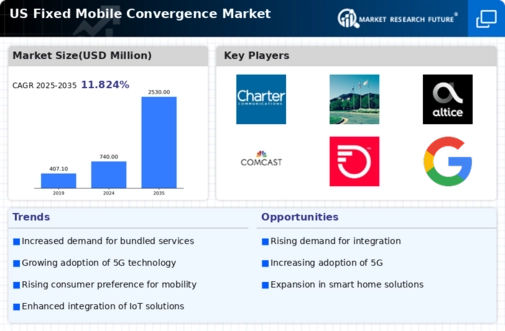The competitive landscape of the US Fixed Mobile Convergence Market showcases a dynamic and rapidly evolving sector characterized by the integration of fixed broadband and mobile services. As operators and service providers strive to stay ahead in a technology-driven environment, they are increasingly focusing on delivering seamless connectivity, enhanced customer experiences, and innovative service bundles. This convergence enables telecom companies to leverage their existing infrastructures and offer comprehensive solutions that cater to diverse consumer needs.
Competitive insights reveal that players in this market are actively engaging in strategic partnerships, leveraging advanced technologies such as 5G, and enhancing their service offerings to retain customer loyalty while also exploring new growth opportunities. As mobile and fixed services continue to intersect, companies are strategically positioning themselves to capitalize on emerging trends.Cox Communications stands out in the US Fixed Mobile Convergence Market with an extensive presence supported by significant strengths in broadband service delivery and customer service.
As a prominent cable television provider, Cox has successfully expanded its portfolio to include mobile offerings, catering to the demand for integrated services among both residential and business customers. The company's infrastructure enables high-speed internet access, which supports its mobile services and facilitates seamless communication experiences for users. By leveraging its extensive network and focus on customer satisfaction, Cox Communications has established a strong foothold in the convergence market, allowing it to provide bundled solutions that enhance user convenience and loyalty.
Furthermore, the company’s commitment to innovation in service delivery has positioned it well in the highly competitive landscape.Sprint Corporation has made its mark in the US Fixed Mobile Convergence Market through its diverse range of telecommunications services and strategic endeavors aimed at enhancing its service capabilities. The company provides a variety of key products, including wireless voice and data services, which are complemented by its efforts in integrating fixed and mobile solutions. Sprint has focused on building a robust 5G network, which significantly enhances its mobile offerings and creates opportunities for more advanced fixed-mobile integration.
The company's strengths lie in its innovative spirit and customer-centric strategies that promote loyalty and satisfaction. Additionally, Sprint has engaged in significant mergers and acquisitions, notably with partners that enhance its market presence and service portfolio, reinforcing its competitive edge. This focus on holistic service solutions and network enhancement positions Sprint favorably within the convergence market in the US.


















